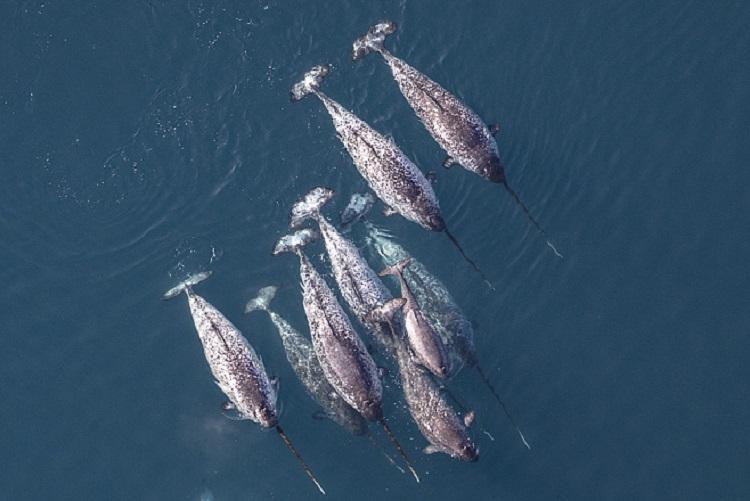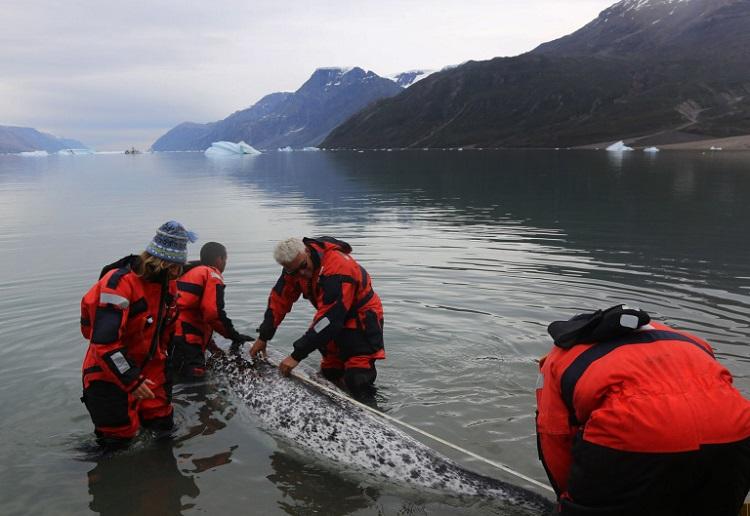
A herd of narwhals with males, females and cubs. carstenegevang.com
Whales with horns
The color of the narwhal, like the hair color of humans, is fickle and changes over the years. The young are gray-blue, mature whales become spotted gray or dark brown, but the color of noble old age is more often white. Narwhals live from 35 to 56 years old. They practically cannot be kept in captivity and die quickly: they need to move a lot, and in the conditions of the aquarium, even the largest, it is impossible to swim such distances.
In the Middle Ages, narwhals were feared, but in fact these whales are not scary at all. Their mouth is small, and their head is huge, lobed, rounded. His eyes are like buttons, but his eyesight is wonderful. The narwhal did not get a fin, but there is a high ridge for maneuvers. The body length reaches up to five meters, the weight is two to three tons. The “sword” on the nose is ten kilograms. In fact, the huge horn that seems to grow right out of the head of these cetaceans is… a tooth. The animal has two of them, and both are upper.
The right tooth is usually like a tooth, but the left one pierces the lip and turns into a strong and flexible tusk, twisted clockwise. “Take care of the tusk from a young age!” is the law for a narwhal: if he manages to break his horn, it will no longer grow, although it will seal itself. Occasionally, the right tooth breaks out, not the left one. Tusks are even rarer in females. It happens that two tusks grow – but this is an exception for 0.2% of the lucky population.
According to the legend of the Eskimos, the narwhal and its horn appeared as follows: one of the goddesses tied a rope, attached a harpoon to the other end and poked it at the whale. The wounded animal decided to make ends meet in the depths of the ocean and carried away the would-be huntress. In the course of the action, she acquired streamlined contours and turned into a narwhal, and her braid twisted from the swirls of the stream and turned into a corkscrew. Conclusion: “Whalers! Observe safety precautions!”
The horn is polished at the tip, and closer to the body, a whole “herbarium” of algae is collected on it. The tusk has many practical applications: for example, during the mating season, it attracts females, it is also a rescue wand for hunting and defense (the narwhal silences opponents with it). Like an ordinary tooth, the horn is a cluster of vessels and nerve cells, and therefore serves as a thermometer and a device for measuring the frequency of electromagnetic waves.
Angering a narwhal is to your detriment, because with a tusk he can even make a hole in a small vessel. As a mammal, the unicorn needs air. For his sake, he can pierce ice seven to eight centimeters thick with a tusk.
Narwhals’ “House parties”
This whale is a loner in its genus, but only according to the classification. In reality, narwhals are sociable, very sociable and keep in packs ranging in size from 3 to 20 individuals. The main mission of the horned family is tourism. In order to protect themselves from Arctic tanning (probably) narwhals migrate along the course of ice drift: in summer they are attracted to the north, and in winter to the south.
It is unrealistic for an animal to freeze – a third of the mass of the “sea unicorn” is fat ten centimeters thick. And yet, from winter frosts, the narwhal sometimes dives 1.5 km, then comes up to breathe – and back into the depths of the sea. And so more than 25 visits per day.
In a large “unicorn” family, sound communication is not complete: moans, mooing, clicking and gurgling are used. By the way, the beluga whale from the expression “howls like a beluga” is related to the narwhal, and so close that sometimes they barrage the seas in consolidated flocks, and occasionally even mutant narwhals appear.

Scientists measure the length of an adult narwhal. Photo: M.P. HEIDE-JORGENSEN, nationalgeographic.com
There are enough people who want to taste narwhal, especially the cubs. Bears guard whales near the polynya, killer whales, polar sharks and walruses in the sea. But the main enemy of all whales was and still is man. Today, commercial extraction is allowed only to aborigines (for example, Canadian and Greenlandic Eskimos), whose narwhal is meat, fuel, ropes and souvenirs from the tusk for sale. But there is a strict ban on females and cubs.
In ancient times, a six-meter narwhal would not surprise anyone. But you have to pay for beauty – the tusks, passed off as the horn of a mythical unicorn, went with a bang as the decor of palaces and thrones. In England, a royal scepter was made from a large tooth. Queen Elizabeth I purchased a narwhal tusk for 10 thousand pounds (the Tower Castle did not cost that much). Pope Julius III was asked for 9,000 thalers for the horn. Ivan the Terrible bought a meter-long tusk for only 700 thalers, and his son Fyodor was later crowned with it.
Why the hype? First of all, the crowned society appreciated the healing properties of the tusk: allegedly, even the plague retreated before the life-giving tooth. At least that’s what the merchants told us when they advertised the product. The horn was wanted in every medicine cabinet of the higher worlds, the pieces of the tusk served as a litmus test for poisons. Therefore, narwhals were killed with great zeal. Gradually, the unicorn horn disappeared from the official lists of pharmacies, giving way to more proven drugs.
Pollution beacons
Since the 70s, the narwhal has been registered in the Red Book in the status of “vulnerable” due to its small number. Although counting narwhals is a so–so idea. Not only are they in the ice all the time, in the underwater frost, but they also swim tens of kilometers a day. Scientists only assume that there are only 50 thousand individuals in the entire boundless north.
The narwhal’s heart rate drops to several per minute when they dive deep to avoid fishing nets. Narwhals themselves feed on everything that Neptune sends. And he sends delicacies: crabs, flounder, shrimp, halibut, cuttlefish, cod… the miner is armed with an echo sounder – a guarantee of successful hunting. But not everything is perfect – the animal’s teeth are in short supply, and therefore the size of the prey is limited.
As soon as the waters warm up in the spring, the “rhinoceroses” start mating games. Females choose partners by ear – according to the principle of “who will sing better”. Well, the tusk, too. The dominance of sea unicorns is not in use, and there is enough joy for everyone. The wait for the offspring lasts about 15 months. There are twins, but rarely. The newborn immediately weighs 80 kg, his height is 1.6 m. Until the age of two or three, the baby is tied to the “mother’s skirt”, because he is breastfed.
And the Monodon monoceros species is a sensitive indicator of climatic perturbations, as well as pollution of Arctic waters. The principle is simple: where the narwhals are, there is cleanliness and order, where they moved from, there is a failure of the ecological system. It’s a small matter: calculate and track the migrations of “unicorns”.
By Vladislav Shcherbak
More amazing facts about the Arctic can be read here.


